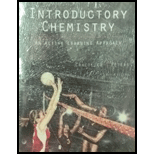
Concept explainers
Interpretation:
The reason as to why it is sometimes difficult to fit a nitrogen atom into a Lewis diagram that obeys the octet rule is to be stated. The species out of
Concept introduction:
Lewis diagram is a representation of the chemical formula of substance with valance electrons of atoms. The Lewis structures are also called electron dot structures. In the Lewis structure, electrons are denoted by dots. Only the valence electrons are presented as dots in the Lewis structure.
Answer to Problem 33E
It is difficult to fit a nitrogen atom into a Lewis diagram that obeys the octet rule as nitrogen has odd number of valence electrons. The Lewis diagram of
Explanation of Solution
To write the Lewis diagram for a compound, first the number of valence electrons is to be calculated.
The electrons which are present in the outermost shell of the atom and occupy the highest energy level of an atom present in its ground state are termed as valence electrons. The number of valence electrons present in the nitrogen atom is
The valence electrons of nitrogen (
The valence electrons of oxygen (
The total number of valence electron for the molecule
The total number of valence electron for the molecule
The valence electrons of fluorine (
The total number of valence electron for the molecule
The total number of valence electron for the molecule
The total number of valence electron for the molecule
The total number of valence electron for the molecule
The valence electrons of chlorine (
The total number of valence electron for the molecule
The total number of valence electron for the molecule
Therefore, as
Nitrogen has an odd number of valence electrons and it is difficult to fit into a Lewis diagram that obeys the octet rule. Lewis diagrams of
Want to see more full solutions like this?
Chapter 12 Solutions
Bundle: Introductory Chemistry: An Active Learning Approach, 6th + LMS Integrated for OWLv2, 4 terms (24 months) Printed Access Card
- How many electron dots should appear in the Lewis structures for each of the following polyatomic ions? a. ClO b. ClO2 c. S22 d. NH4+arrow_forwardDraw a Lewis structure for each of the following molecules or ions: (a) CS (b) BF4 (c) HNO2 (where the arrangement of atoms is HONO) (d) OSCl2 (where S is the central atom)arrow_forwardA polyatomic ion is composed of C, N, and an unknown element X. The skeletal Lewis structure of this polyatomic ion is [XCN]. The ion X2 has an electron configuration of [Ar]4s23d104p6. What is element X? Knowing the identity of X, complete the Lewis structure of the polyatomic ion, including all important resonance structures.arrow_forward
- For each of the following, use formal charges to choose the Lewis formula that gives the best description of the electron distribution: a ClO2F b SO2 c ClO3arrow_forwardSuccessive substitution of F atoms for H atoms in the molecule NH3 produces the molecules NH2F, NHF2, and NF3. a. Draw Lewis structures for each of the four molecules. b. Using VSEPR theory, predict the geometry of each of the four molecules. c. Specify the polarity (polar or nonpolar) for each of the four molecules.arrow_forwardDraw Lewis structures for the following molecules or polyatomic ions. a. SO3 b. SO32arrow_forward
- Four hypothetical elements, A, B, C, and D, have electronegativities A = 3.4, B = 3.1, C = 2.5, end D = 1.7. These elements form the compounds CB, DC, DA, and BA. Arrange the compounds in order of a. Increasing ionic bond character b. Decreasing covalent bond characterarrow_forwardn your own words, what is meant by the term electronegativity? What are the trends across and down the periodic table for electronegativity? Explain them, and describe how they are consistent with trends of ionization energy and atomic radii.arrow_forwardDraw Lewis structures for the following polyatomic ions. a. OH b. BeH42 c. AlCl4 d. NO3arrow_forward
- Consider the pyrosulfate ion, S2O72-. It has no sulfur–sulfur nor oxygen–oxygen bonds. (a) Write a Lewis structure for the pyrosulfate ion using only single bonds. (b) What is the formal charge on the sulfur atoms for the Lewis structure you drew in part (a)? (c) Write another Lewis structure using six bonds and two O—S bonds. (d) What is the formal charge on each atom for the structure you drew in part (c)?arrow_forwardThe study of carbon-containing compounds and their properties is called organic chemistry. Besides carbon atoms, organic compounds also can contain hydrogen, oxygen, and nitrogen atoms (as well as other types of atoms). A common trait of simple organic compounds is to have Lewis structures where all atoms have a formal charge of zero. Consider the following incomplete Lewis structure for an organic compound called histidine (an amino acid), which is one of the building blocks of proteins found in our bodies: Draw a complete Lewis structure for histidine in which all atoms have a formal charge of zero.arrow_forward
 General, Organic, and Biological ChemistryChemistryISBN:9781285853918Author:H. Stephen StokerPublisher:Cengage Learning
General, Organic, and Biological ChemistryChemistryISBN:9781285853918Author:H. Stephen StokerPublisher:Cengage Learning Introductory Chemistry: A FoundationChemistryISBN:9781337399425Author:Steven S. Zumdahl, Donald J. DeCostePublisher:Cengage Learning
Introductory Chemistry: A FoundationChemistryISBN:9781337399425Author:Steven S. Zumdahl, Donald J. DeCostePublisher:Cengage Learning Chemistry: The Molecular ScienceChemistryISBN:9781285199047Author:John W. Moore, Conrad L. StanitskiPublisher:Cengage Learning
Chemistry: The Molecular ScienceChemistryISBN:9781285199047Author:John W. Moore, Conrad L. StanitskiPublisher:Cengage Learning
 Chemistry: An Atoms First ApproachChemistryISBN:9781305079243Author:Steven S. Zumdahl, Susan A. ZumdahlPublisher:Cengage Learning
Chemistry: An Atoms First ApproachChemistryISBN:9781305079243Author:Steven S. Zumdahl, Susan A. ZumdahlPublisher:Cengage Learning ChemistryChemistryISBN:9781305957404Author:Steven S. Zumdahl, Susan A. Zumdahl, Donald J. DeCostePublisher:Cengage Learning
ChemistryChemistryISBN:9781305957404Author:Steven S. Zumdahl, Susan A. Zumdahl, Donald J. DeCostePublisher:Cengage Learning





